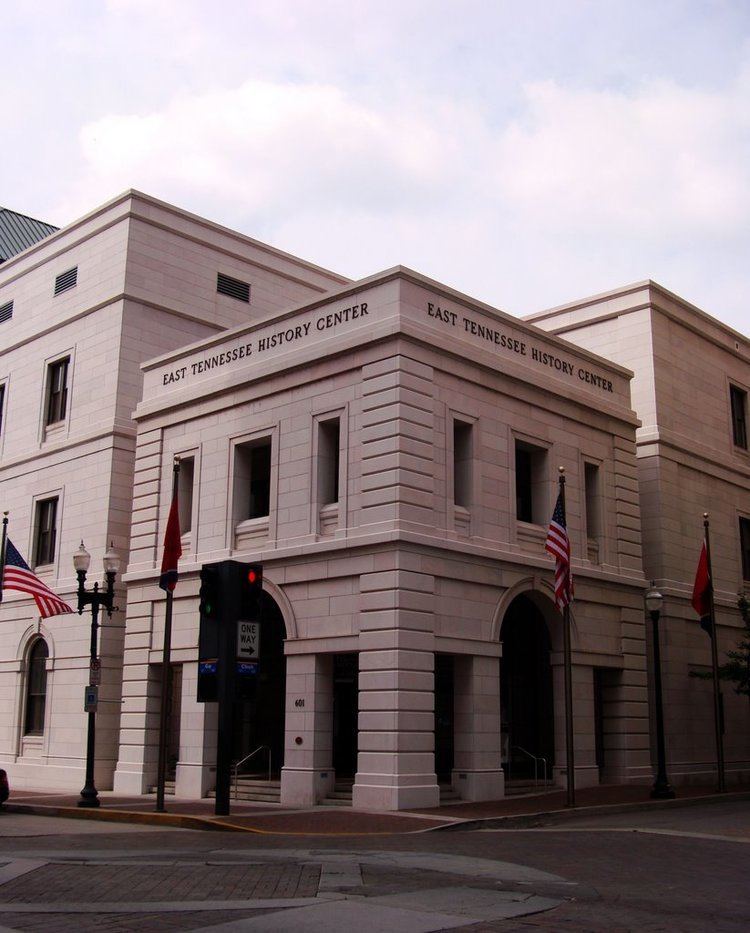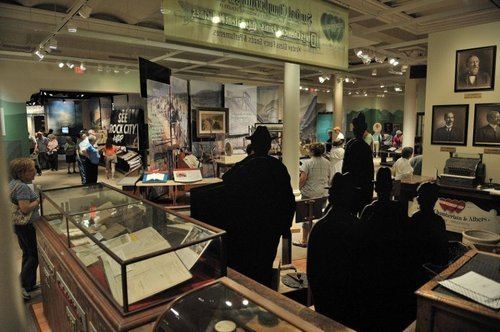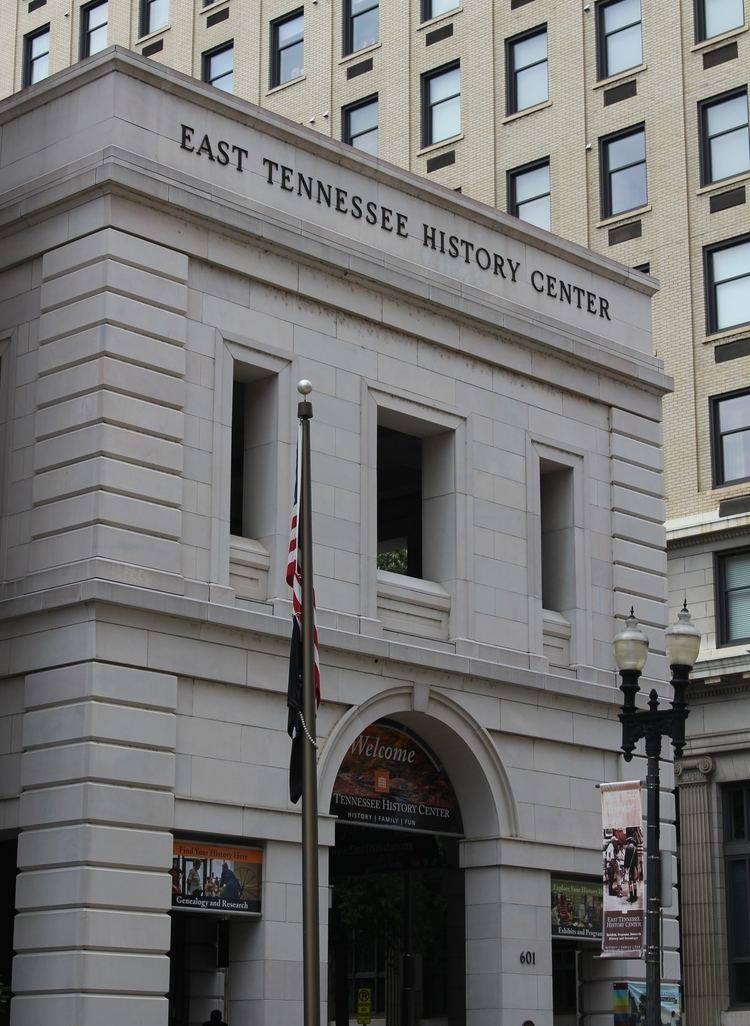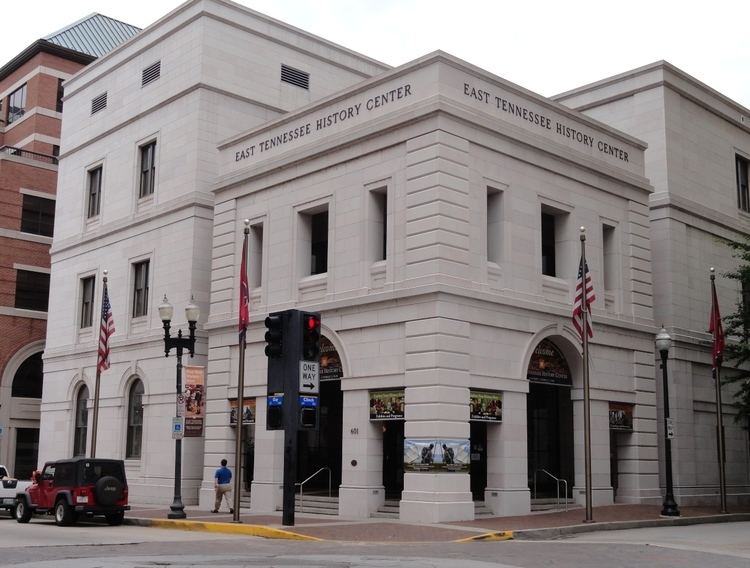Abbreviation ETHS Executive Director Cherel Henderson Founded 5 May 1834 | President Joe Emert Founder J. G. M. Ramsey | |
 | ||
Formation May 5, 1834 (1834-05-05) Similar Museum of Appalachia, Johnson University, Children's Museum of Oak Ridge, American Association for State, Lincoln Memorial University Profiles | ||
Mvi 4301 avi east tennessee historical society
The East Tennessee Historical Society (ETHS), headquartered in Knoxville, Tennessee, United States, is a non-profit organization dedicated to the study of East Tennessee history, the preservation of historically significant artifacts, and educating the citizens of Tennessee. The Society also operates a museum and museum shop in the East Tennessee History Center on Gay Street in downtown Knoxville. The East Tennessee Historical Society was established in 1834, only 38 years after the establishment of the state of Tennessee, to record the history of the development and settlement of the area.
Contents
- Mvi 4301 avi east tennessee historical society
- Mvi 4312 avi east tennessee historical society
- History
- Publications
- List of books published by the ETHS
- Reprints and revisions
- East Tennessee History Center
- First Families of Tennessee and Civil War Families of Tennessee
- References

Mvi 4312 avi east tennessee historical society
History
The East Tennessee Historical and Antiquarian Society was founded by early Tennessee historian J. G. M. Ramsey (1797–1884), who was concerned that many of the state's early pioneers were dying off, and sought to archive their papers and correspondence. The first meeting of the Society was held on May 5, 1834. East Tennessee College president William B. Reese was elected as the first president. The executive committee included Ramsey's brother-in-law John Hervey Crozier and stepbrother Thomas William Humes. Ramsey, as the Society's recording secretary, gradually acquired a sizeable collection of papers and correspondence from early Tennesseans such as William Blount, John Sevier, Samuel Wear, Alexander Outlaw, and James Hubbert. The "Antiquarian" had been dropped from the Society's name by 1852.

Ramsey kept the Society's archives at his plantation, Mecklenburg, just east of Knoxville. During the Civil War, Ramsey was a very vocal Confederate and secessionist, and was forced to flee when the Union Army occupied Knoxville in 1863, leaving behind his library and the Society's archives. An arsonist (allegedly hired by Ramsey's rival, William "Parson" Brownlow) burned Mecklenburg, effectively destroying the archives. By the end of the war, the Society had largely disintegrated.

In January 1883, several Confederate veterans, led by Moses White and William Henderson (with some assistance from the aging Ramsey and Crozier), revived the East Tennessee Historical Society as an auxiliary of the Southern Historical Association. An 1885 ad for the group shows U.T. professor William Gibbs McAdoo as president and future Knoxville mayor Samuel G. Heiskell as vice president. Other members included newspaper editor William Rule and scholar Eben Alexander. The Society hosted lectures on Fort Loudoun, Irish nationalist John Mitchel, and the State of Franklin, and featured speakers such as Fitzhugh Lee. The Society also admitted women for the first time. By the end of the century, however, this second incarnation of the ETHS was no longer active.

In December 1924, several Knoxville-area educators and librarians met at the Lawson McGhee Library to discuss reviving the ETHS. The first official meeting of the new Society took place on January 16, 1925. Charter members included U.T. professor Philip Hamer, Lawson McGhee librarian Mary U. Rothrock, and U.T. dean (and later president) James Hoskins. The Calvin M. McClung Collection offered the Society use of its office space and staff. The Society began publishing its annual scholarly journal in 1929, and hosted lectures by historians Stanley J. Folmsbee and Samuel Cole Williams. The Society published its first book, Folmsbee's Sectionalism and Internal Improvements in Tennessee, in 1939.

In 1946, the Society published a comprehensive history of Knox County, The French Broad-Holston Country, as part of the state's sequicentennial celebrations. The book, edited by Rothrock, included a history of the county written by Folmsbee, and contributions by Harvey Broome and several other ETHS members. A revised edition was published in 1972.

In 1976, the Society published a comprehensive history of Knoxville, entitled, Heart of the Valley: A History of Knoxville, Tennessee. This book was edited by Lucile Deaderick, and included a general history of the city by William MacArthur. MacArthur's history was republished in the 1982 book, Knoxville: Crossroads of the New South, which included several hundred photographs from the McClung Collection.

In the late 1970s, Knox County acquired the Old Customs House (which had been used by the Tennessee Valley Authority prior to the construction of the TVA Towers), and allotted the space to the McClung Collection and the Knox County Archives. The ETHS set up its headquarters on the building's second floor, and hired a professional staff. During the 1980s, under the directorship of Charles Faulkner Bryan and Mark Wetherington, membership virtually doubled. During the tenure of W. Todd Groce as executive director (1990-1995), the ETHS renamed its scholarly publication as the Journal of East Tennessee History, created the First Families of Tennessee project in 1992, and established the Museum of East Tennessee History in 1993.
Publications
Since 1929, the Society has published an annual collection of scholarly essays on the history and culture of East Tennessee. Initially known simply as the Society's Publications, this work has been published as the Journal of East Tennessee History since 1990. The journal covers topics on a wide range of historical and cultural issues related to East Tennessee and the Southern Appalachian region, including the American Civil War, the early settlement of East Tennessee, post-Civil War Reconstruction, the Great Depression, World War I and World War II, as well as more recent events such as the 1982 World's Fair. The Society also publishes two other magazine format titles, the tri-annual "Tennessee Ancestors" and the quarterly newsletter "Newsline".
List of books published by the ETHS
Reprints and revisions
East Tennessee History Center
The headquarters of the East Tennessee Historical Society are located in the East Tennessee History Center, in the Old Customs House building in downtown Knoxville, which is owned by Knox County. This building, which is depicted in the ETHS logo, is home to the Historical Society's Museum of East Tennessee History, which depicts cultural and historical exhibits from around the region. Displays include items owned by early Tennesseans such as Davy Crockett and John Sevier, memorabilia from events such as the Appalachian expositions of 1910 and 1911, artifacts from the Battle of Fort Sanders, a complete trolley car, a drugstore display, and early country music instruments and memorabilia. The Center also displays works by regional artists such as Lloyd Branson, Adelia Armstrong Lutz, Catherine Wiley, and Joseph Knaffl.
The History Center also contains the Knox County Archives and the Calvin M. McClung Collection of the Knox County Public Libraries. The McClung Collection is one of the preeminent genealogical research facilities in the Southeastern United States. Free lectures and courses designed to encourage individuals to research their family histories as well as educate them in the proper way to conduct such research are given on a regular basis.
First Families of Tennessee and Civil War Families of Tennessee
The East Tennessee Historical Society maintains two honorary organizations for genealogical research. The First Families of Tennessee is an organization of individuals who are able to trace their ancestry to families residing in the area that became Tennessee prior to statehood. The Civil War Families of Tennessee is an organization of individuals whose ancestors fought in the American Civil War on either side.
